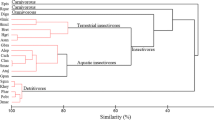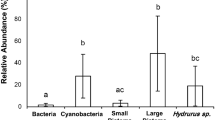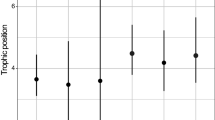Abstract
The influence of predatory fish on the structure of stream food webs may be altered by the presence of forest canopy cover, and consequent differences in allochthonous inputs and primary production. Eight sites containing introduced brown trout (Salmo trutta) and eight sites that did not were sampled in the Cass region, South Island, New Zealand. For each predator category, half the sites were located in southern beech (Nothofagus) forest patches (range of canopy cover, 65–90%) and the other half were in tussock grassland. Food resources used by two dominant herbivores-detritivores were assessed using stable isotopes. 13C/12C ratios were obtained for coarse particulate organic matter (CPOM), fine particulate organic matter (FPOM), algal dominated biofilm from rocks, and larvae of Deleatidium (Ephemeroptera) and Olinga (Trichoptera). Total abundance and biomass of macroinvertebrates did not differ between streams with and without trout, but were significantly higher at grassland sites than forested sites. However, taxon richness and species composition differed substantially between trout and no-trout sites, irrespective of whether streams were located in forest or not. Trout streams typically contained more taxa, had low biomass of predatory invertebrates and large shredders, but a high proportion of consumers with cases or shells. The standing stock of CPOM was higher at forested sites, but there was less FPOM and more algae at sites with trout, regardless of the presence or absence of forest cover. The stable carbon isotope range for biofilm on rocks was broad and encompassed the narrow CPOM and FPOM ranges. At trout sites, carbon isotope ratios of Deleatidium, the most abundant invertebrate primary consumer, were closely related to biofilm values, but no relationship was found at no-trout sites where algal biomass was much lower. These results support a role for both bottom-up and top-down processes in controlling the structure of the stream communities studied, but indicate that predatory fish and forest cover had largely independent effects.




Similar content being viewed by others
References
Allan JD (1983) Predator-prey relationships in streams. In: Barnes JR, Minshall GW (eds) Stream ecology: application and testing of general ecological theory. Plenum, New York, pp 191–229
Allan JD (1995) Stream ecology. Kluwer Academic, Dordrecht
Bechara JA, Moreau G, Planas D (1992) Top-down effects of brook trout (Salvelinus fontinalis) in a boreal stream. Can J Fish Aquat Sci 49:2093–2103
Biggs BJF (1996) Patterns in benthic algae in streams. In: Stevenson JR, Bothwell ML, Lowe RL (eds) Algal ecology. Academic Press, San Diego, pp 31–56
Biggs BJF, Francoeur SN, Huryn AD, Young R, Arbuckle CJ, Townsend CR (2000) Trophic cascades in streams: effects of nutrient enrichment on autotrophic and consumer benthic communities under two different fish predation regimes. Can J Fish Aquat Sci 57:1380–1394
Brönmark C, Weisner SEB (1996) Decoupling of cascading trophic interactions in a freshwater, benthic food chain. Oecologia 108:534–541
Bowlby JN, Roff JC (1986) Trophic structure in southern Ontario streams. Ecology 67:1670–1679
Collier KJ, Winterbourn MJ (1990) Population dynamics and feeding of mayfly larvae in some acid and alkaline New Zealand streams. Freshw Biol 23:181–189
Cooper SD (1988) The responses of aquatic insects and tadpoles to trout. Verh Int Verein Limnol 23:1698–1703
Cooper SD, Walde SD, Peckarsky BL (1990) Prey exchange rates and the impact of predators on prey populations in streams. Ecology 71:1503–1514
Cowx IG (1983) Review of the methods for estimating fish population size from survey removal data. Fish Manage 14:67–82
Dahl J (1998) The impact of vertebrate and invertebrate predators on a stream benthic community. Oecologia 117:217–226
Dahl J, Greenberg L (1996) Impact on stream benthic prey by benthic vs. drift feeding predators: a meta-analysis. Oikos 77:177–181
Death RG, Winterbourn MJ (1994) The measurement of environmental stability in streams: a multivariate approach. J N Am Benthol Soc 13:125–139
Diehl S (1993) relative consumer sizes and the strengths of direct and indirect interactions in omnivorous feeding relationships. Oikos 68:151–157
Diehl S, Cooper SD, Kratz KW, Nisbet RM, Roll, SK, Wiseman SW, Jenkins TM Jr (2000) Effects of multiple predator-induced behaviors on short-term producer-grazer dynamics in open systems. Am Nat 156:293-313
Dillon WR, Goldstein M (1984) Multivariate analysis methods and applications. Wiley, New York
Dobson M, Hildrew AG, Orton SS, Ormerod SJ (1995) Increasing litter retention in moorland streams—ecological and management aspects of a field experiment. Freshw Biol 33:325–337
Englund G (1997) Importance of spatial scale and prey movements in predator caging experiments. Ecology 78:2316–2325
Ernest SKM, Brown JH (2001) Homeostasis and compensation: The role of species and resources in ecosystem stability. Ecology 82:2118–2132
Flecker AS, Townsend CR (1994) Community-wide consequences of trout introduction in New Zealand streams. Ecol Appl 4:798–807
Forrester GE, Dudley TL, Grimm NB (1999) Trophic interactions in open systems: effects of predators and nutrients on stream food chains. Limnol Oceanogr 44:1187–1197
Friberg N, Winterbourn MJ, Shearer KA, Larsen SE (1997) Benthic communities of forest streams in the South Island, New Zealand: effects of forest type and location. Arch Hydrobiol 138:289–306
Glova GJ, Sagar PM, Näslund I (1992) Interaction for food and space between populations of Galaxias vulgaris Stokell and juvenile Salmo trutta L. in a New Zealand stream. J Fish Biol 41:909–925
Gupta S, Michael RG, Gupta A (1993) Influence of diet on growth, food retention time, and gill ventilation rate of nymphs of Cloeon sp. (Ephemeroptera: Baetidae). Hydrobiologia 271:41–44
Hansson L-A, Brönmark C, Nyström P, Greenberg L, Lundberg P, Nilsson A, Persson A, Petterson LB, Romare P, Tranvik L (1998) Consumption patterns, complexity and enrichment in aquatic food chains. Proc R Soc Lond 265:901–906
Hildrew AG (1996) Food webs and species interactions. In: Petts G, Calow P (eds) River biota, diversity and dynamics. Blackwell, Oxford, pp 123–144
Hill WR (1996) Effects of light. In: Stevenson JR, Bothwell ML, Lowe RL (eds) Algal ecology. Academic Press, San Diego, pp 121–148
Hill WR, Ryon MG, Schilling EM (1995) Light limitation in a stream ecosystem: responses by primary producers and consumers. Ecology 76:1297–1309
Holt RD, Lawton JH (1994) The ecological consequences of shared natural enemies. Annu Rev Ecol Syst 25:495-520
Holt RD, Grover J, Tilman D (1994) Simple rules for interspecific dominance in systems with exploitative and apparent competition. Am Nat 144:741–771
Hunter MD, Price PW (1992) Playing chutes and ladders: heterogeneity and the relative roles of bottom-up and top-down forces in natural communities. Ecology 73:724–732
Huryn AD (1996) An appraisal of the Allen paradox in a New Zealand trout stream. Limnol Oceanogr 41:243–252
Huryn AD (1998) Ecosystem-level evidence for top-down and bottom-up control of production in a grassland stream system. Oecologia 115:173–183
Jefferies RL (2000) Allochthonous inputs: integrating population changes and food-web dynamics. Trends Ecol Evol 15:19–22
Kohler SL, McPeek MA (1989) Predation risk and the foraging behavior of competing stream insects. Ecology 70:1811–1825
Kuhara N, Nakano S, Miyasaka H (1999) Interspecific competition between two stream insect grazers mediated by non-feeding predatory fish. Oikos 87:27–35
Lamberti GA, Resh VH (1983) Stream periphyton and insect herbivores: an experimental study of grazing by a caddisfly population. Ecology 64:1124–1135
Ledger ME, Winterbourn MJ (2000) Growth of New Zealand stream insect larvae in relation to food type. Arch Hydrobiol 149:353–364
Leibold MA (1996) A graphical model of keystone predators in food webs: trophic regulation of abundance, incidence, and diversity patterns in communities. Am Nat 147:784–812
Lester PJ, Mitchell SF, Scott D (1994) Willow leaf and periphyton chemical composition, and the feeding preferences of Olinga feredayi (Trichoptera: Conoesucidae). N Z J Mar Freshw Res 28:13–18
McCune B, Mefford MJ (1999) PC-ORD. Multivariate analysis of ecological data. MjM Software Design, Gleneden Beach, Oregon
McIntosh AR (2000a) Aquatic predator-prey interactions. In: Collier KJ, Winterbourn MJ (eds) New Zealand stream invertebrates: ecology and implications for management. New Zealand Limnological Society, Christchurch, pp 125–156
McIntosh AR (2000b) Habitat- and size-related variations in exotic trout impacts on native galaxiid fishes in New Zealand. Can J Fish Aquat Sci 57:2140–2151
McIntosh AR, Townsend CR (1995) Impacts of an introduced predatory fish on mayfly grazing in New Zealand streams. Limnol Oceanogr 40:1508–1512
McIntosh AR, Townsend CR (1996) Interactions between fish, grazing invertebrates and algae in a New Zealand stream: a trophic cascade mediated by fish-induced changes to grazer behaviour? Oecologia 108:174–181
McMurtrie SA (2000) Interactive effects of disturbance, food supply and predators on Zelandopsyche ingens (Trichoptera). MSc thesis, University of Canterbury, Christchurch, New Zealand
McQueen DJ, Johannes MRS, Post JR (1989) Bottom-up and top-down impacts on freshwater pelagic community structure. Ecol Monogr 59:289–309
Murakami M, Nakano S (2002) Indirect effect of aquatic insect emergence on a terrestrial insect population through predation by birds. Ecol Lett 5:333–337
Nakano S, Miyasaka H, Kuhara N (1999) Terrestrial-aquatic linkages: riparian arthropod inputs alter trophic cascades in a stream food web. Ecology 80:2435–2411
Nisbet RM, Diehl S, Wilson WG, Cooper SD, Donaldson DD, Kratz K (1997) Primary-productivity gradients and short-term population dynamics in open systems. Ecol Monogr 67:535-553
Oksanen L, Fretwell S, Arruda J, Niemela P (1981) Exploitation of ecosystems in gradients of primary productivity. Am Nat 118:240–261
Osenberg CW, Mittelbach GG (1996) The relative importance of resource limitation and predator limitation in food chains. In: Polis GA, Winemiller KO (eds) Food webs: integration of patterns and dynamics. Chapman and Hall, New York, pp 134–148
Peacor SD (2002) Positive effects of predators on prey growth rate through induced modifications of prey behavior. Ecol Lett 5:77–85
Peacor SD, Werner EE (1997) Trait-mediated indirect interactions in a simple aquatic food web. Ecology 78:1146–1156
Peacor SD, Werner EE (2000) Predator effects on an assemblage of consumers through induced changes in consumer foraging behavior. Ecology 81:1998–2010
Peterson BJ, Fry BF (1987) Stable isotopes in ecosystem studies. Annu Rev Ecol Syst 18:293–320
Polis GA, Strong DR (1996) Food web complexity and community dynamics. Am Nat 147:813–846
Polis GA, Winemiller KO (1996) Food webs: integration of patterns and dynamics. Chapman and Hall, New York
Power ME (1990) Effects of fish on river food webs. Science 250:411–415
Power ME (1992) Top-down and bottom-up forces in food webs: do plants have primacy? Ecology 73:733–746
Quinn JM, Smith BJ, Burrell GP, Parkyn SM (2000) Leaf litter characteristics affect colonisation by stream invertebrates and growth of Olinga feredayi (Trichoptera: Conoesucidae). N Z J Mar Freshw Res 34:273–287
Richardson JS (1991) Seasonal food limitation of detritivores in a montane stream: an experimental test. Ecology 72:873–887
Ruetz et al (2002) Top-down control in a detritus-based food web: fish, shredders, and leaf breakdown. Oecologia 132:307–315
Rounick JS, Winterbourn MJ, Lyon GL (1982) Differential utilization of allochthonous and autochthonous inputs by aquatic invertebrates in some New Zealand streams: a stable carbon isotope study. Oikos 39:191–198
Sabo JL, Power ME (2002) River-watershed exchange: effects of riverine subsidies on riparian lizards and their terrestrial prey. Ecology 83:1860–1869
Scarsbrook M (2000) Life-histories. In: Collier KJ, Winterbourn MJ (eds) New Zealand stream invertebrates: ecology and implications for management. New Zealand Limnological Society, Christchurch, pp 76–99
Schmitz OJ, Beckerman AP, O`Brien KM (1997) Behaviorally mediated trophic cascades: effects of predation risk on food web interactions. Ecology 78:1388–1399
Thorp JH (1986) Two distinct roles for predators in freshwater assemblages. Oikos 47:75–82
Trussel GC, Ewanchuk PJ, Bertness MD (2002) Field evidence of trait-mediated indirect interactions in a rocky intertidal food web. Ecol Lett 5:241–245
Wallace JB, Gurtz ME (1986) Response of Baetis mayflies (Ephemeroptera) to catchment logging. Am Midl Nat 115:25–41
Wallace JB, Eggert SL, Meyer JL, Webster JR (1997) Multiple trophic levels of a forest stream linked to terrestrial litter inputs. Science 277:102–104
Werner EE, Anholt BR (1996) Predator-induced behavioral indirect effects: consequences to competitive interactions in anuran larvae. Ecology 77:157–169
Winterbourn MJ (2000) Feeding ecology. In: Collier KJ, Winterbourn MJ (eds) New Zealand stream invertebrates: ecology and implications for management. New Zealand Limnological Society, Christchurch, pp 100–124
Winterbourn MJ, Davis SF (1976) Ecological role of Zelandopsyche ingens (Trichoptera: Oeconesidae) in a beech forest stream ecosystem. Aust J Mar Freshw Res 27:197–215
Winterbourn MJ, Cowie B, Rounick JS (1984) Food resources and ingestion patterns of insects along a West Coast, South Island, river system. N Z J Mar Freshw Res 18:379–388
Winterbourn MJ, Gregson KLD, Dolphin CH (2000) Guide to the aquatic insects of New Zealand. Bull Entomol Soc N Z 13
Wooster DE, Sih A, Englund G (1997) Prey dispersal and predator impacts on stream benthic prey. In: Streit B, Städler T, Lively CM (eds) Evolutionary ecology of freshwater animals. Birkhäuser, Basel, pp 89–116
Wootton JT, Power ME (1993) Productivity, consumers, and the structure of a river food chain. Proc Natl Acad Sci USA 90:1384–1387
Acknowledgements
We thank Rennie Bishop for assistance with the field work. Lars-Anders Hansson, Anders Nilsson, Sebastian Diehl and an anonymous reviewer gave valuable comments on an earlier version of the manuscript. This study was financed by a post doctoral fellowship from Wenner-Gren foundations to P.N. and research grants from the University of Canterbury. Tracey Robinson helped prepare the manuscript.
Author information
Authors and Affiliations
Corresponding author
Appendix
Appendix
Abundance
Mean invertebrate abundance (individuals per m2 ±1 SE, n=4) of 58 aquatic taxa found at open and forested sites with and without trout (P predator, G grazer, F filter feeder, S shredder, N non-feeder of aquatic food sources.
Taxa | Functional Group | No trout | Trout | ||
|---|---|---|---|---|---|
|
| Open | Forest | Open | Forest |
Megaloptera | |||||
Archichauliodes | P | 42±25 | 1±1 | 6±4 | 9±5 |
Ephemeroptera | |||||
Austroclima | G | 38±27 | 19±19 | 14±10 | 36±27 |
Coloburiscus | F | 140±140 | 1±1 | 98±72 | 127±76 |
Deleatidium | G | 1,107±264 | 646±177 | 1,358±261 | 650±77 |
Neozephlebia | G | 0 | 1±1 | 0 | 1±1 |
Nesameletus | G | 22±9 | 151±114 | 7.2±6.2 | 9±5 |
Oniscigaster | G | 2±2 | 0 | 1±1 | 0 |
Plecoptera | |||||
Austroperla | S | 5±5 | 15±13 | 0 | 5±5 |
Cristaperla | G | 1±1 | 0 | 0 | 1±1 |
Halticoperla | G | 0 | 0 | 0 | 1±1 |
Spaniocerca | G | 51±50 | 56±32 | 7±6 | 20±6 |
Stenoperla | P | 3±3 | 22±7 | 10±7 | 8±5 |
Taraperla | G | 0 | 6±6 | 0 | 0 |
Zelandobius | G | 13±5 | 27±16 | 6±2 | 9±3 |
Zelandoperla | G | 1±1 | 5±2 | 0 | 1± 1 |
Trichoptera | |||||
Aoteapsyche | F | 10±7 | 1±1 | 50±26 | 17±7 |
Beraeoptera | G | 15±10 | 0 | 385±136 | 113±60 |
Costachorema | P | 24±20 | 2±2 | 10±2 | 0 |
Edpercivalia | P | 2±2 | 2±2 | 0 | 0 |
Helicopsyche | G | 170±170 | 0 | 0 | 0 |
Hudsonema | G | 1±1 | 0 | 0 | 0 |
Hydrobiosella | F | 8±5 | 0 | 32±31 | 47±29 |
Hydrobiosis | P | 3±3 | 11±6 | 8±5 | 8±3 |
Hydrochorema | P | 1±1 | 0 | 2±1 | 4±2 |
Neurochorema | P | 0 | 42±42 | 0 | 26±24 |
Oeconesus | S | 2±2 | 0 | 0 | 1±1 |
Olinga | G | 70±31 | 35±8 | 138±61 | 106±16 |
Philorheithrus | P | 5±4 | 6±3 | 5±3 | 6±5 |
Polyplectropus | P | 0 | 0 | 2±2 | 0 |
Psilochorema | P | 3±3 | 0 | 7±5 | 5±4 |
Pycnocentria | G | 0 | 1±1 | 45±43 | 0 |
Pycnocentrodes | G | 0 | 1±1 | 26±13 | 46±28 |
Triplectides | S | 0 | 0 | 2±2 | 0 |
Zelandopsyche | S | 3±3 | 6±3 | 6±6 | 3±0 |
Zelolessica | G | 1±1 | 0 | 43±21 | 17±7 |
Coleoptera | |||||
Elmidae | G | 1±1 | 44±41 | 40±21 | 238±67 |
Hydraenidae | G | 3±1 | 5±2 | 6±5 | 6±3 |
Hydrophilidae | G | 2±2 | 17±7 | 10±7 | 10±4 |
Ptilodactylidae | G | 6±6 | 0 | 0 | 0 |
Scirtidae | G | 96±72 | 10±6 | 2±2 | 1±1 |
Diptera | |||||
Aphrophila | G | 10±6 | 0 | 86±47 | 10±6 |
Austrosimulium | F | 18±12 | 134±127 | 250±85 | 60±35 |
Chironomidae | G | 172±93 | 34±5 | 377±295 | 73±16 |
Empididae | G | 2±2 | 2±1 | 1±1 | 1±1 |
Eriopterini | G | 2±1 | 2±2 | 3±2 | 4±2 |
Hexatomini | G | 3±1 | 1±1 | 2±1 | 0 |
Muscidae | P | 13±13 | 0 | 5±5 | 0 |
Nothodixa | G | 0 | 1±1 | 0 | 0 |
Pelecorhynchidae | P | 0 | 2±2 | 0 | 3±3 |
Tanyderidae | G | 0 | 0 | 1±1 | 0 |
Mollusca | |||||
Potamopyrgus | G | 146±81 | 10±10 | 64±41 | 55±38 |
Sphaerium | F | 0 | 0 | 1±1 | 0 |
Platyhelminthes | |||||
Neppia | P | 314±161 | 41±16 | 13±5 | 50±42 |
Nematoda | P | 0 | 0 | 1±1 | 0 |
Nematomorpha | N | 1±1 | 0 | 1 | 0 |
Annelida | |||||
Oligochaeta | G | 46±26 | 38±22 | 58±42 | 29±22 |
Amphipoda | |||||
Paraleptamphopus | G | 0 | 0 | 1±1 | 5±5 |
Acari | P | 0 | 0 | 1±1 | 0 |
Rights and permissions
About this article
Cite this article
Nyström, P., McIntosh, A.R. & Winterbourn, M.J. Top-down and bottom-up processes in grassland and forested streams. Oecologia 136, 596–608 (2003). https://doi.org/10.1007/s00442-003-1297-1
Received:
Accepted:
Published:
Issue Date:
DOI: https://doi.org/10.1007/s00442-003-1297-1




